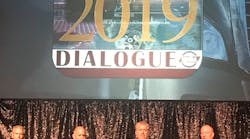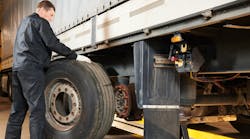During Heavy Duty Aftermarket Dialogue 2019, held in conjunction with the Heavy Duty Aftermarket Week in Las Vegas on January 28, a panel discussion among original equipment manufacturers provided perspective on the relationship between OEs and the aftermarket. Heavy Duty Aftermarket Week is organized by the Heavy Duty Manufacturers Association (HDMA).
Titled “The Real World View: A Global Perspective,” discussions centered around future vehicle technologies, including automation, electrification and the increased use of data. These topics focused on the shift in service requirements for these vehicles.
The panel featured Roger Nielsen, president and CEO of original equipment commercial vehicle manufacturer Daimler Trucks North America (DTNA); Dean Engelage, president of trailer manufacturer Great Dane; and Ken Davis, founder of Greentree Advisors, a consulting company to the global vehicle industry. Davis also previously held executive positions at power management company Eaton Corp.
Future vehicle technologies
When it comes to future technologies, DTNA’s Nielsen noted there is a much stronger proven business case for automation compared to vehicle electrification. A number of vehicle safety systems which are the basis for automated vehicle systems – including adaptive cruise control, collision warning and lane departure warning systems – have already proven themselves valuable to fleets. In addition, some argue more fully automated systems may provide a future outlet to address the truck driver shortage.
Daimler recently introduced the first Level 2 automation Class 8 tractor-trailer during the Consumer Electronics Show (CES) in early January, which featured adaptive cruise control and introduced lateral controls advancing lane departure warning to mitigation.
“The business case for automation is very high, but the technology is not there,” Nielsen said. “The next level for automation will probably take 10 years before we get there.”
As it pertains to parts suppliers and the aftermarket, panelists emphasized the need for products to allow for the growth and development of automated systems.
“Trucks today have 400 sensors, 100,000,000 lines of code, six SIM cards,” Nielsen explains. “What we need from the supply base is changing.”
Implications to the aftermarket with servicing future vehicles
The industry will see a significant shift in the skill set required by service technicians, according to Greentree Advisors' Davis. The required skills will focus on understanding vehicle software, diagnostics and sensor replacement, he adds.
Current diagnostic practices involve determining the fault codes of the vehicle, and determining if the issue is software- or hardware-related. From there technicians will hone in on the area of the vehicle requiring service or replacement parts.
"We’re seeing the trend where fleets aren’t outsourcing the maintenance, but having technicians from dealership going directly to the fleet," says DTNA's Nielsen. "They have the ability to draw on the diagnostics and tools at the dealership, and bring it back to the fleet."
Panelists reaffirmed the continued shift to prognostics, as the collection and analysis of data from different vehicle systems continues to evolve.
“The vision we have is to tie in all the sensors to our aftermarket network, and by geofencing (and other telematics functionality) alert the nearest location of the next service opportunity,” says Great Dane’s Engelage. “It should result in a lot more efficiencies.”
Notably, service providers will be able to anticipate parts needs and have those parts on-hand before the vehicle arrives for service.
“The vision, of course, is we want to be able to predict when a failure is going to occur,” Nielsen says. “While (the component or system) is still working, but before it fails.”
As noted earlier, the business case for vehicle electrification seems more difficult to prove at present. In particular, the biggest barriers are due to the current cost and weight of the battery packs themselves.
“The battery technology will be key," Davis says. "It will have a significant impact on the supply base for those who build mechanical parts versus electronic parts. It’s got to cost justify itself."
However, this technology is continually advancing. Many suppliers have already begun to adapt vehicle systems suitable for both traditional internal combustion engine platforms and for the the possibility of use in fully electric drivetrains, with introductions and improvements to systems such as electronic power steering pumps, for example.
The shift away from mechanical systems will mean fewer parts overall on the vehicle. There are an estimated 7,000 parts for a fully battery electric vehicle, compared to 30,000 parts required for a traditional internal combustion engine, according to Nielsen.
Opportunities and challenges for aftermarket suppliers
Opportunities for aftermarket suppliers include adapting to the opportunities afforded by evolving vehicle technology, and also partnering with OEs to provide education and training for the service of these vehicles.
"We need aftermarket suppliers to educate the dealers," says DTNA's Nielsen. "It’s impossible for us to take on full responsibility to train and service different options, especially as technology increases."
Nielsen also advises aftermarket suppliers will become increasingly important when it comes to the supply chain and parts delivery, in order to provide parts quickly for the increasing number of vehicle configurations available.
Data will play an ever-critical role in the success of aftermarket companies in the commercial vehicle market as well.
“For the current supply base, suppliers need to understand what the data is coming off the vehicle for their componentry,” Greentree Advisor's Davis explains. “The ability to understand what’s happening to the drivetrain dynamically will allow us to understand the system for diagnostics and prognostics. It's in the best interest of the OEs to share that information because it will make their operation better.”
A thorough understanding and evaluation of these parts by analyzing the data can also assist in optimizing changes to the design of those parts for future vehicles as well.
Panelists echoed the necessity of organizations throughout the commercial vehicle industry - including OEs, the aftermarket and fleets managing and operating these vehicles - to be able to share data, in order to best optimize the design, operation and service of commercial vehicles.
The access to this compilation data may ultimately allow a shift from preventive maintenance to predictive maintenance, through prognostics.
Vehicle prognostics would allow fleets the ability to anticipate parts or system failure before it occurs, based on comparable data from a similar set of operating parameters.
But, Nielsen advises this can be difficult due to the increased volume of data, and the necessity of having all data available to paint a full picture of the vehicle's performance.
"As we get deeper into that data, it’s the fusion of that data (that is critical), because not all trucks operate in the same conditions," says DTNA's Nielsen. "For prognostics, it’s up to the application of the vehicle."



